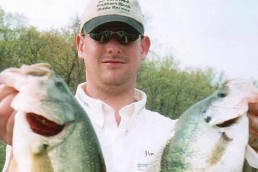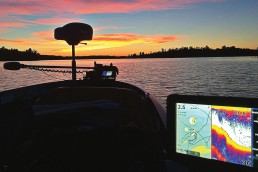Pontoon Therapy: The More, the Merrier
SHARE THIS POST
While boats and motors have obviously grown larger, faster and more expensive over the years, the notion that folks today are getting priced out of the fishing game doesn’t hold water. If you feel the competitive need for a tournament-grade fishing machine and your budget can accommodate your desires, by all means, go for it. If not, well, that doesn’t mean you’re relegated to fishing off the bank and using a stick as a pole.
There are loads of other options offering an array of fishing platforms: canoes, kayaks, car toppers and waders. These provide broader access to smaller or remote waters where mega-boats can’t be launched, and can produce fish for those on a budget.
Beyond that, there’s another option that’s been around for a long time that has been a “right-sized” choice all along. I’m talking about pontoons, which have always been larger than typical fishing boats, and are typically just not loaded with as much horsepower.
Most pontoons feature something between 35 and 115 hp, although, admittedly, today there’s an array of triple-tubes capable of sporting two or even three 200-hp-plus outboards. Something tells me these aren’t primarily for crappie fishing and are targeted more toward the watersports crowd.
The fact is, just look around and do a count on your local waters; chances are you’ll tally up a whole lot more pontoons than you thought. A whole lotta folks use them for fishing, cruising and idling the day away on the water. Always have. Always will.
Pontoons provide spacious, stable platforms for families, kids, dogs and assorted groups. There’s room to get up and move around when the boat’s not in motion and there’s a fence around the outer perimeter to corral everyone and everything inside.
Are you enjoying this post?
You can be among the first to get the latest info on where to go, what to use and how to use it!
Some pontoons are geared more for pleasure cruising. Some, especially those with rear platforms and tow bars, are more designed for skiing, tubing, swimming and watersports. Those with lowered corners and pedestal seating are designed more for fishing applications and often feature livewells and even baitwells. So, they’re not all one-size-fits-all. But you can shop for what you want and choose what best suits your desires.
Pontoons can easily be rigged out with depth finders, pontoon-mount (bow) electric-trolling motors, and even electrics that mount on the cavitation plate of your main outboard. Minn Kota’s DeckHand electric anchors and stern-mounted Talons (extendable poles that hold your boat’s position in 12 feet of water or less) make fishing easy and effective, even in windy conditions. In stronger winds, you can even back-troll with ease; waves flow smoothly under the platform, between the tubes, with no jolting impact or spray. With a little practice, you’ll find you can do pretty much everything in a pontoon that you can do in a boat—and with a whole lot more friends on board.
Let’s Go Fishing, the volunteer-based 501(c) 3 non-profit that takes thousands of seniors, veterans and youths fishing and boating for free in Minnesota and northern Wisconsin every year, has pioneered the use of pontoons for just this purpose. Wheelchair ramps and wider doors provide access to nursing home residents who otherwise might not be able to attend such outings. The flat, stable surface is ideal for those with balance issues and the canopy provides shade for folks who need to stay out of the sun.
I’m not saying that you want 10 people flinging muskie baits on a pontoon, mind you—that would be asking for trouble. But eight to 10 slip-bobber setups work out pretty well for panfishing. So do four to six people fishing for bass or walleyes, providing everyone coordinates their own casts and movements.
In short, if you’re in the market for a new fishing boat, consider a pontoon among your options. And if you’re interested in a little firsthand experience aboard one before committing to a purchase, check out one of the local Let’s Go Fishing Chapters who will be glad to provide you, your family, or group of friends a ride. Just go their website, click on the chapter nearest you and follow the instructions for scheduling a trip. Chances are you’ll come away with a new appreciation for fishing off a flattop. If nothing else, you should be able to pull a few fish up and over the rails and make some new friends in the process.
MWO
SHARE THIS POST
Did you enjoy this post?
You can be among the first to get the latest info on where to go, what to use and how to use it!
Dave Csanda
Dave Csanda has enjoyed 40 years in the fishing communications industry at In-Fisherman, Angling Edge and now, as editor of MidWest Outdoors. He is an inductee of both the Minnesota and National Fresh Water Fishing Halls of Fame.



